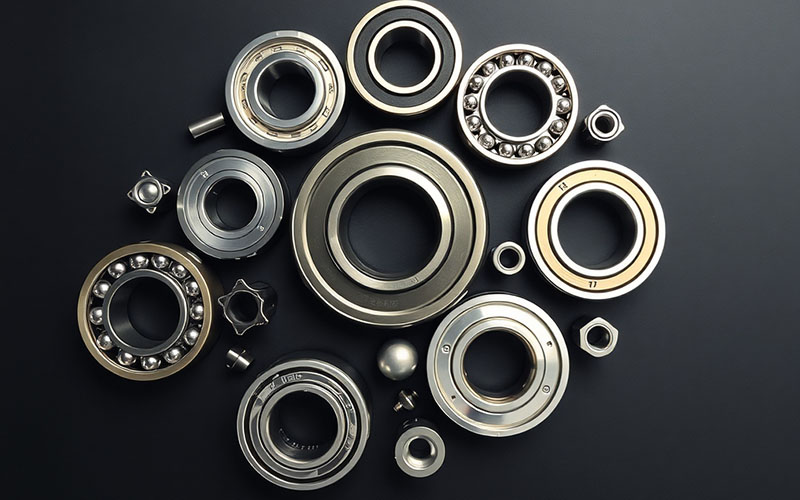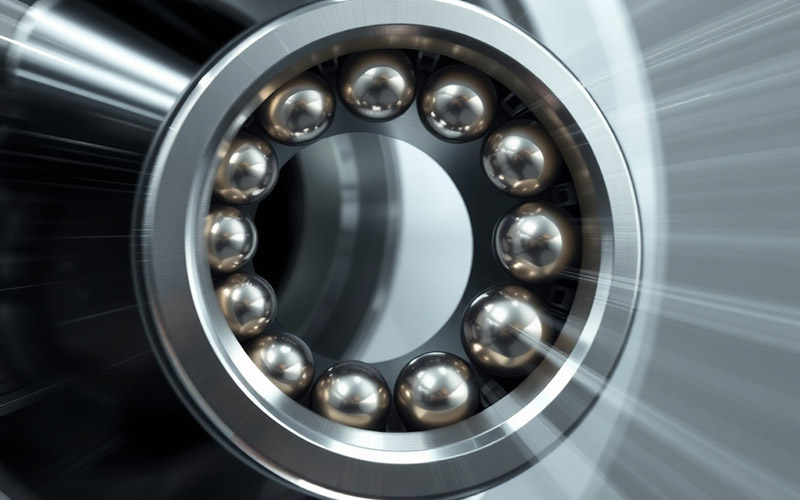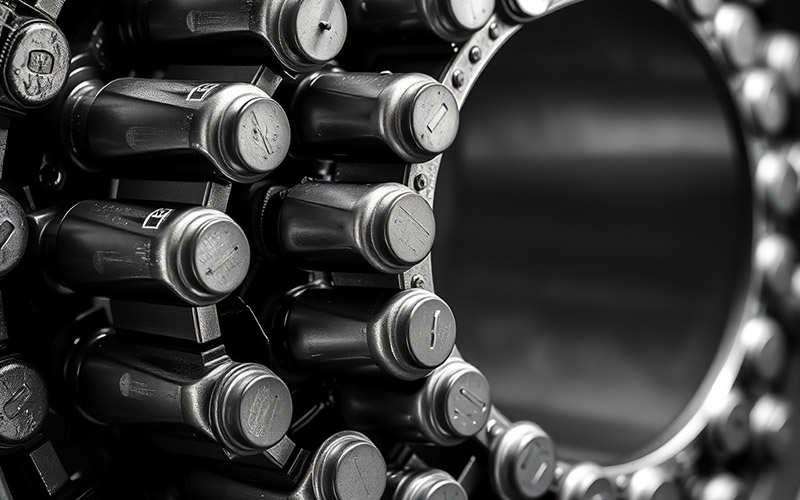Lassen Sie sich von Istar mit unserer Erfahrung und unserem Know-how beim Start Ihres Projekts unterstützen!
Laden Sie Ihre Designdateien und Produktionsanforderungen hoch und wir melden uns innerhalb von 30 Minuten bei Ihnen!

Over my many years working with machines, I’ve learned that some of the smallest parts are the most important. Take bearings, for example. These amazing little parts are very important to the machine industry, and for a good reason. From your car to the things in your home, almost everything with moving parts uses a bearing. In this article, I’ll share my experiences and what I’ve learned about the different kinds of bearings. We will look at everything from the common ball bearing to the advanced magnetic bearing. You’ll learn the purpose of bearings, how they work, and how to pick the right one for your needs. This knowledge is good for anyone who works with or is just curious about the machines that power our world.
In my experience, the main purpose of bearings is to make moving parts slide easier. Think about a spinning shaft. Without a bearing, the shaft would rub right on its holder. This would make a lot of rubbing and heat. The parts would wear out fast and waste power. A bearing sits between the shaft and the holder. It lets them move smoothly with less rubbing. This simple but smart job is why bearings are used in so many machines.
Bearings also hold up and guide spinning parts. They carry the weight of the moving part and pass it to the frame holding it. This weight can be a radial load, which pushes from the side of the shaft. It can also be an axial load, which pushes along the length of the shaft. Some bearings can handle both kinds of loads. By holding up the shaft, a bearing makes sure it stays in the right spot. This is very important for any machinery to work the right way.
The ball bearing is probably the most common type of bearing you will find. I’ve seen them in many things, from electric motors to roller skates. A ball bearing uses small, round balls to keep the inner and outer rings of the bearing apart. Because the balls are round, they touch the rings in a very small spot. This lets them spin with very low friction. This makes the ball bearing great for high-speed applications.
There are different kinds of ball bearings for different jobs. Deep groove ball bearings are the most widely used kind and can handle both radial and axial loads. Angular contact ball bearings are made to take both radial and axial loads at the same time. For things that go at very high speeds, you might use a special high-speed ball bearing. The fact that a ball bearing can be used in so many ways makes it a top pick for many builders. Picking the right bearing, and the right kind of ball bearing, is a big step in making good machinery.

When I have a heavy weight to move, I often think about the roller bearing. A ball bearing uses round balls, but a roller bearing uses rollers shaped like cans or other shapes. This change in shape is very important. A roller has a bigger area of contact with the rings than a ball does. This spreads the weight over a bigger area. This gives the roller bearing a much higher load capacity. That’s why roller bearings are often found in heavy machines like conveyor belts and car transmissions.
The shape of the roller can be different, which leads to different kinds of roller bearings. Cylindrical roller bearings have rollers shaped like cans. A spherical roller bearing has rollers shaped like barrels. This lets it handle shafts that are not lined up perfectly. Then there is the needle roller bearing, which uses long, thin rollers. This special type of roller bearing is good for places where there is not much room. The roller bearing shows how a simple change in shape can make a part with very different and strong abilities. The roller bearing is a special type of bearing made for hard jobs.
Yes, for sure. In my time with heavy machines, the tapered roller bearing is a real workhorse. What makes this roller bearing special is the shape of its rollers and rings—they are sloped, like a piece of a cone. If you drew lines from the roller and the rings, they would all meet at one spot on the center line of the bearing. This special taper shape lets the tapered roller bearing handle both heavy radial and axial loads. The sharper the angle of the taper, the more axial load the bearing can hold.
You’ll often find a tapered roller bearing in places like car wheels and gearboxes. They are often used in pairs to handle push loads in both directions. The power of the tapered roller bearing to take heavy loads and both radial and axial loads makes it a must-have in many factory and car uses. When you have a heavy load, picking a tapered roller bearing is often the right move. Tapered roller bearings are designed to handle tough work.
I use a thrust ball bearing when I need to handle push loads that go in one direction. Think of a spinning stool. The bearing that lets it spin smoothly with your weight on it is a kind of thrust bearing. A thrust ball bearing is made of a ring of balls held by two washers. They are made to handle loads that are in line with the shaft. This type of bearing is great for light-push jobs where there is not much side load.
There are also roller thrust bearings, which use rollers instead of balls. These can handle much higher push loads. You might see a roller thrust bearing in a car’s transmission. For example, some gears in transmissions make axial loads that need a thrust bearing to hold them. A thrust ball bearing is a special tool for a special job. Knowing when to use this type of bearing is important for anyone who builds machines.
| Bearing Kind | Main Load Direction | Gemeinsame Nutzung |
|---|---|---|
| Thrust Ball Bearing | Axial (Push) | Spinning Stool |
| Roller Thrust Bearing | Axial (Push) | Car Transmission |
When I need to handle high side loads at fast speeds, I often find that cylindrical roller bearings are the best choice. This kind of roller bearing has rollers that are shaped like cans. This gives them a bigger contact area with the rings than a ball bearing has. This lets them hold a heavy radial load. The way cylindrical roller bearings are made leads to low friction. This makes them good for high-speed applications.
You’ll find cylindrical roller bearings in things like gearboxes and electric motors. They are very stiff and can also carry some push loads. Some kinds of cylindrical roller bearings let the inner ring and outer ring come apart, which can make them easier to put together. When a job needs both high load capacity and high-speed work, the cylindrical roller bearing is a great pick. This bearing type is a good example of how a special roller shape can be made just right for certain jobs.
Sometimes, the easy answer is the best one. That’s how I feel about the plain bearing. A plain bearing is the simplest type of bearing. It’s just a tube that a shaft spins inside of. There are no rolling parts like balls or rollers. Instead, the parts slide against each other. This might sound like it would rub a lot, but a thin layer of oil or grease between the shaft and the bearing surface lets it move smoothly.
Plain bearings, also called sleeve bearings, are small, light, and can carry a lot of weight. They are also much quieter than bearings with rolling parts. I’ve seen them used in many factory jobs, especially in places with high loads and slow speeds. Because they are so simple, they often cost less than other kinds of bearings. The plain bearing is a good reminder that good machine design does not always have to be hard. The plain bearing is a special type of bearing that works in a different way to do its job.
Now, let’s talk about some of the more high-tech kinds of bearings. I’ve been able to work with fluid bearings and magnetic bearings, and they are really neat. A fluid bearing uses a thin layer of liquid or gas under pressure to hold the load. This means the moving parts never touch. This leads to very low rubbing and almost no wear. Fluid bearings are often used in high-load, high-speed jobs like in turbines and in machines that need to be very exact.
Magnetic bearings go one step more. Like their name says, magnetic bearings use magnets to float a spinning shaft. This means there is no touching at all, which leads to zero rubbing and no wear from parts touching. Magnetic bearings can handle the fastest speeds of any bearing kind. You’ll find magnetic bearings in high-tech jobs like in machines that work with nuclear fuel and high-speed tools. These advanced bearing types show the amazing new ideas in machines and building.

Picking the right bearing for a job is a very important choice. I’ve learned that you need to think about a few things. The first is the load. You need to know if the bearing will have a radial load, an axial load, or both. How much load is also important. For light loads, a ball bearing might be okay, but for a heavy load, you’ll probably need a roller bearing.
The speed of the job is another key thing to think about. Ball bearings are usually better for high-speed jobs, while some roller bearings are better for slower speeds. You also need to think about parts not lining up right. If the shaft and holder might not be perfectly straight, a spherical roller bearing or a self-aligning ball bearing could be the right pick. Last, the place where it will work, like the heat and dirt, will also affect your choice. Taking the time to think about all these things will help you pick the right bearing and make sure your machinery lasts a long time and works well.
It’s really neat to think about all the different ways bearings are used. I’ve seen them in almost every kind of work. In the car world, bearings are in wheels, transmissions, and engines. In your home, they are in refrigerators, washing machines, and ceiling fans. The airplane industry depends on high-quality bearings for everything from jet engines to satellites.
Even in places you might not think of, bearings are working hard. Wind turbines use huge bearings to let the blades spin smoothly. The conveyor belts that move boxes in a big storeroom use tons of roller bearings. From the tiny bearings in a watch to the giant bearings in a tunnel digging machine, these parts are key to our modern world. The large number of bearing kinds shows the many different jobs they are used for.
Here are some of the most important things to remember: